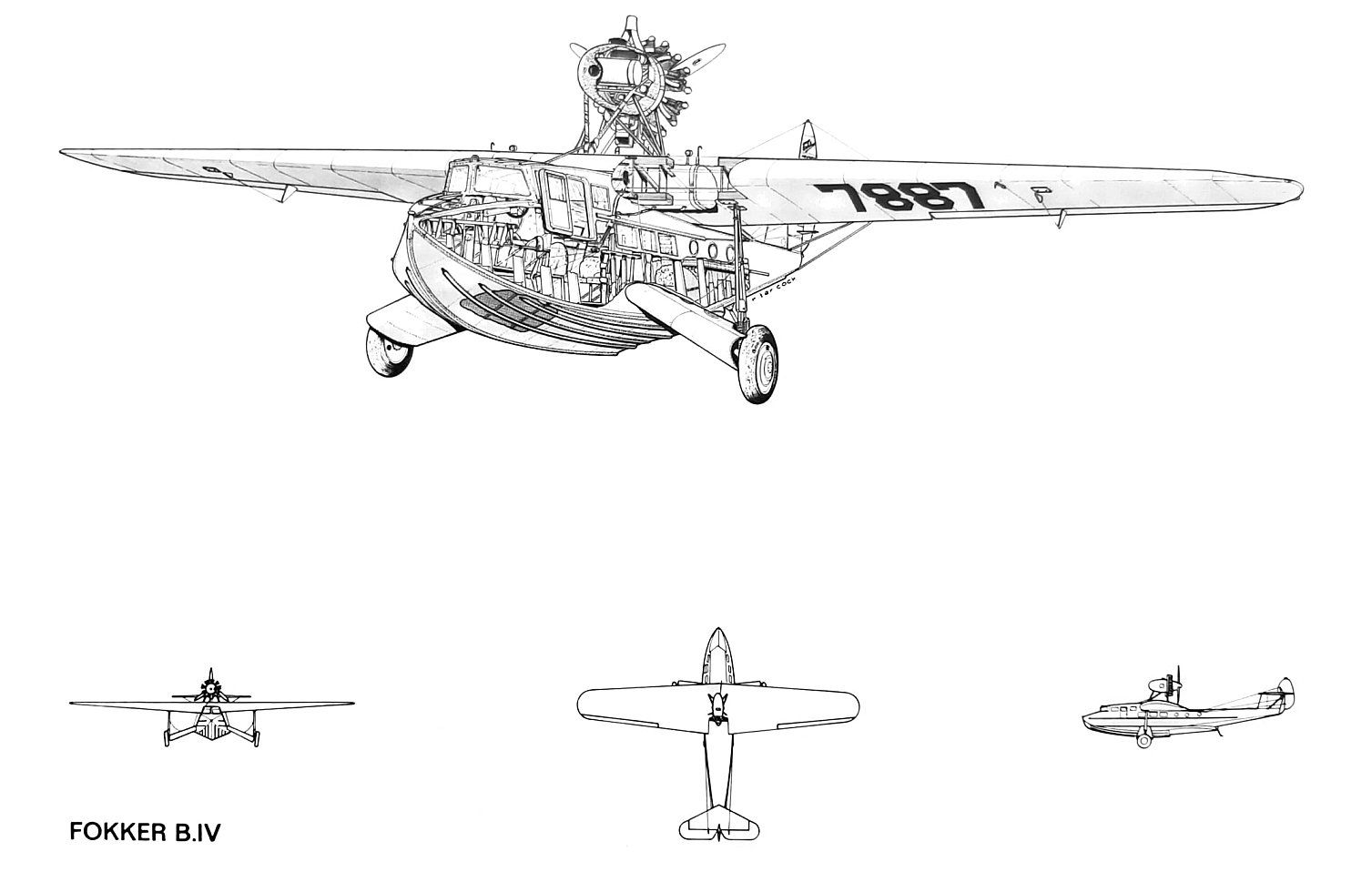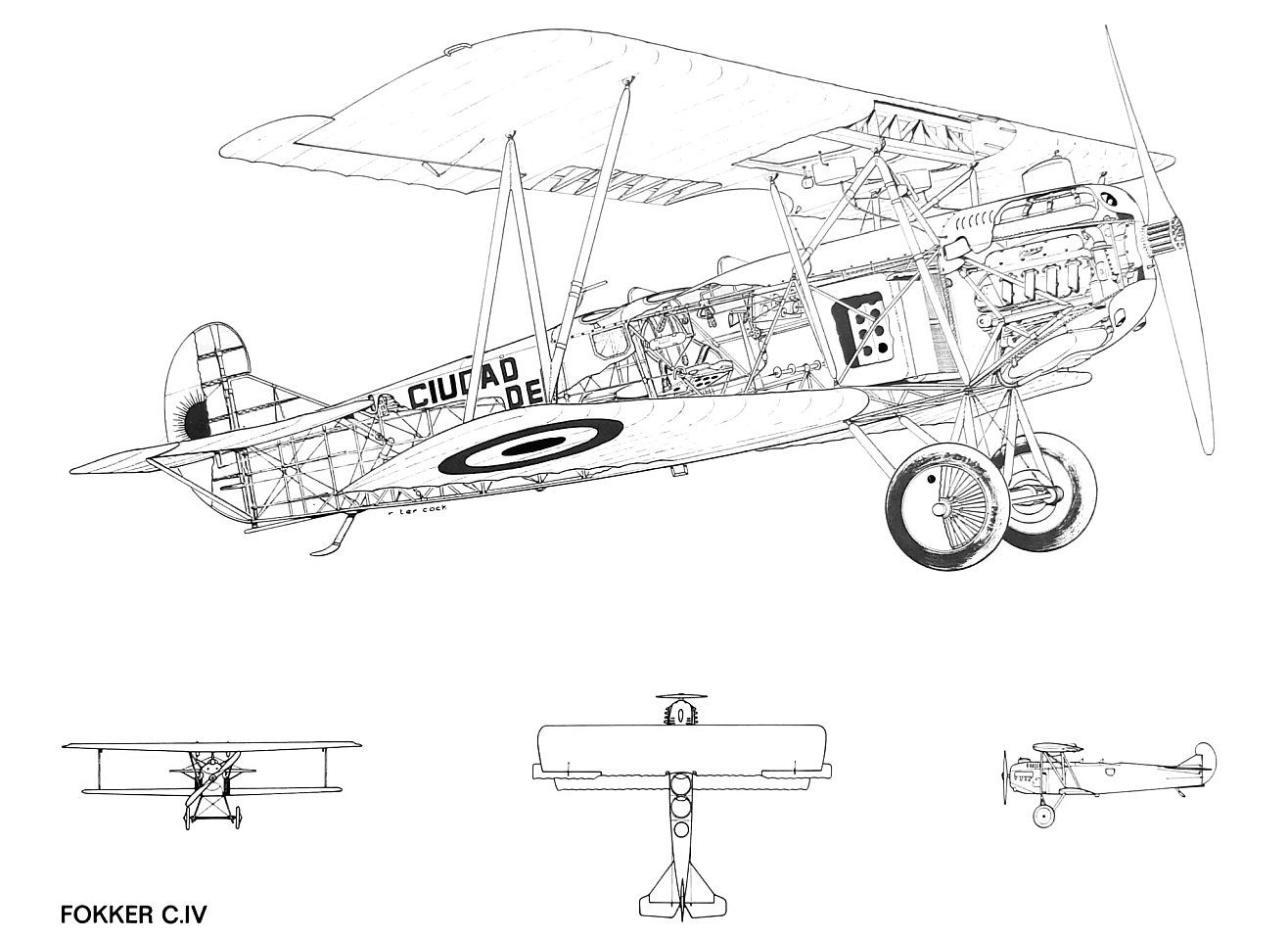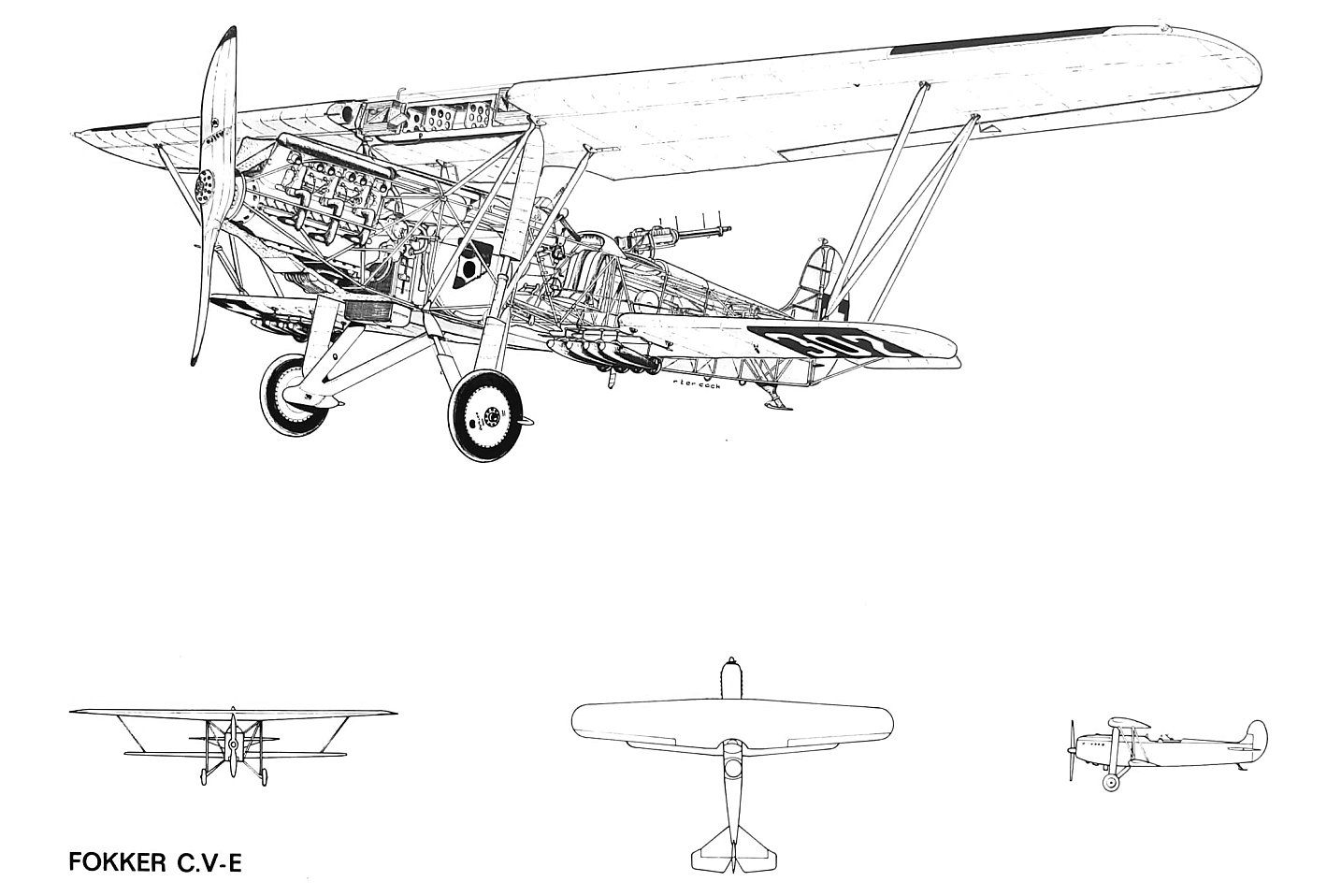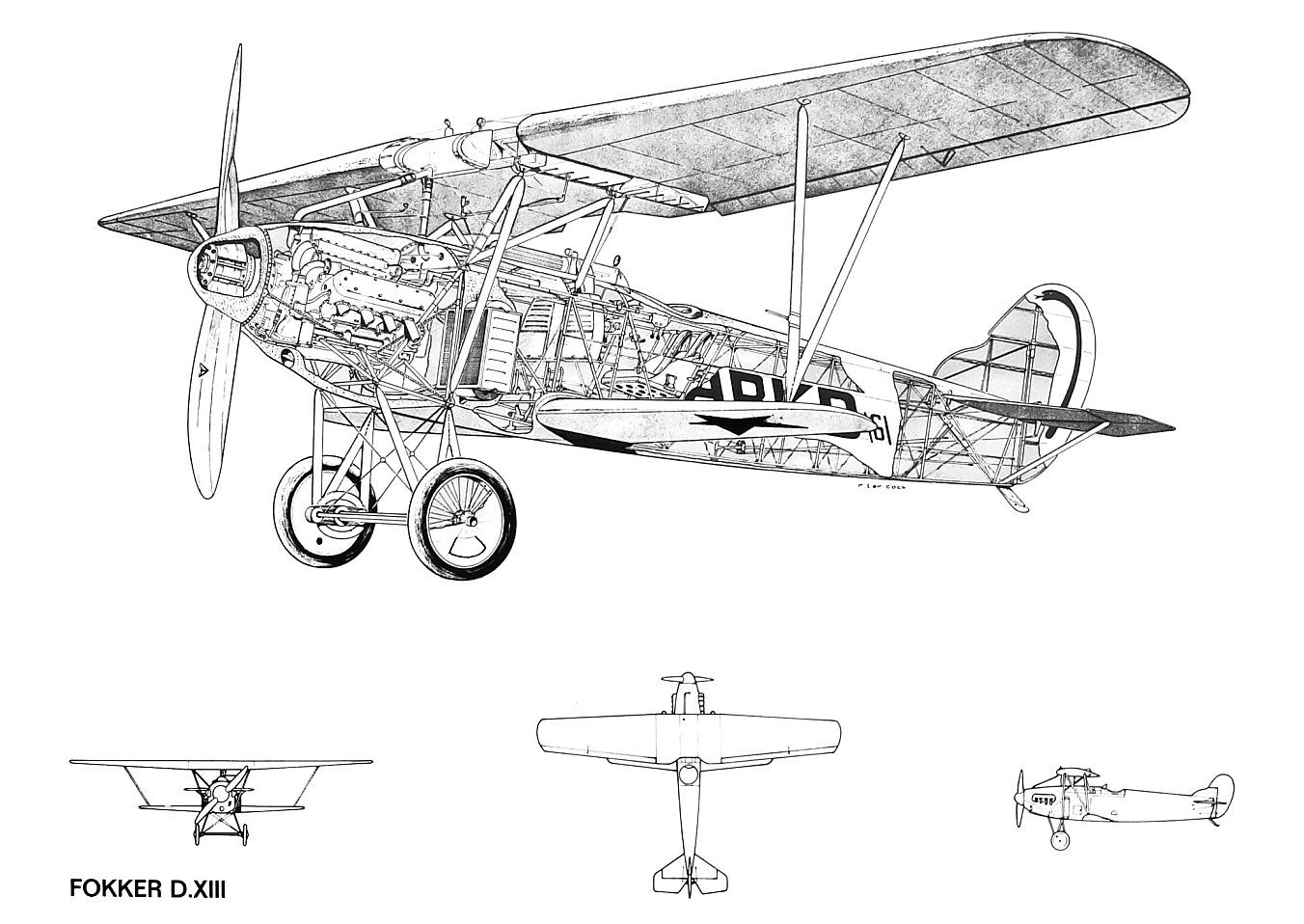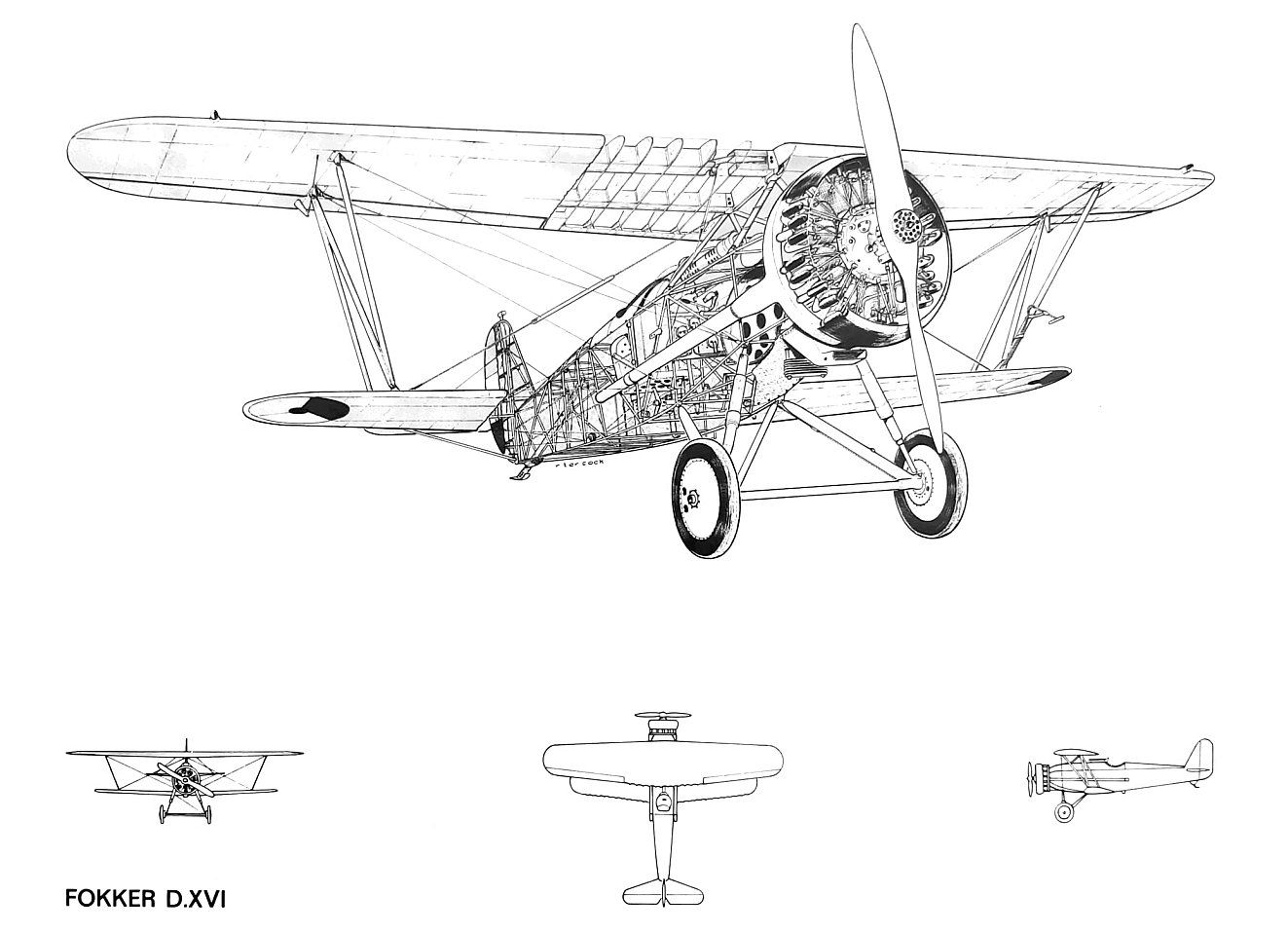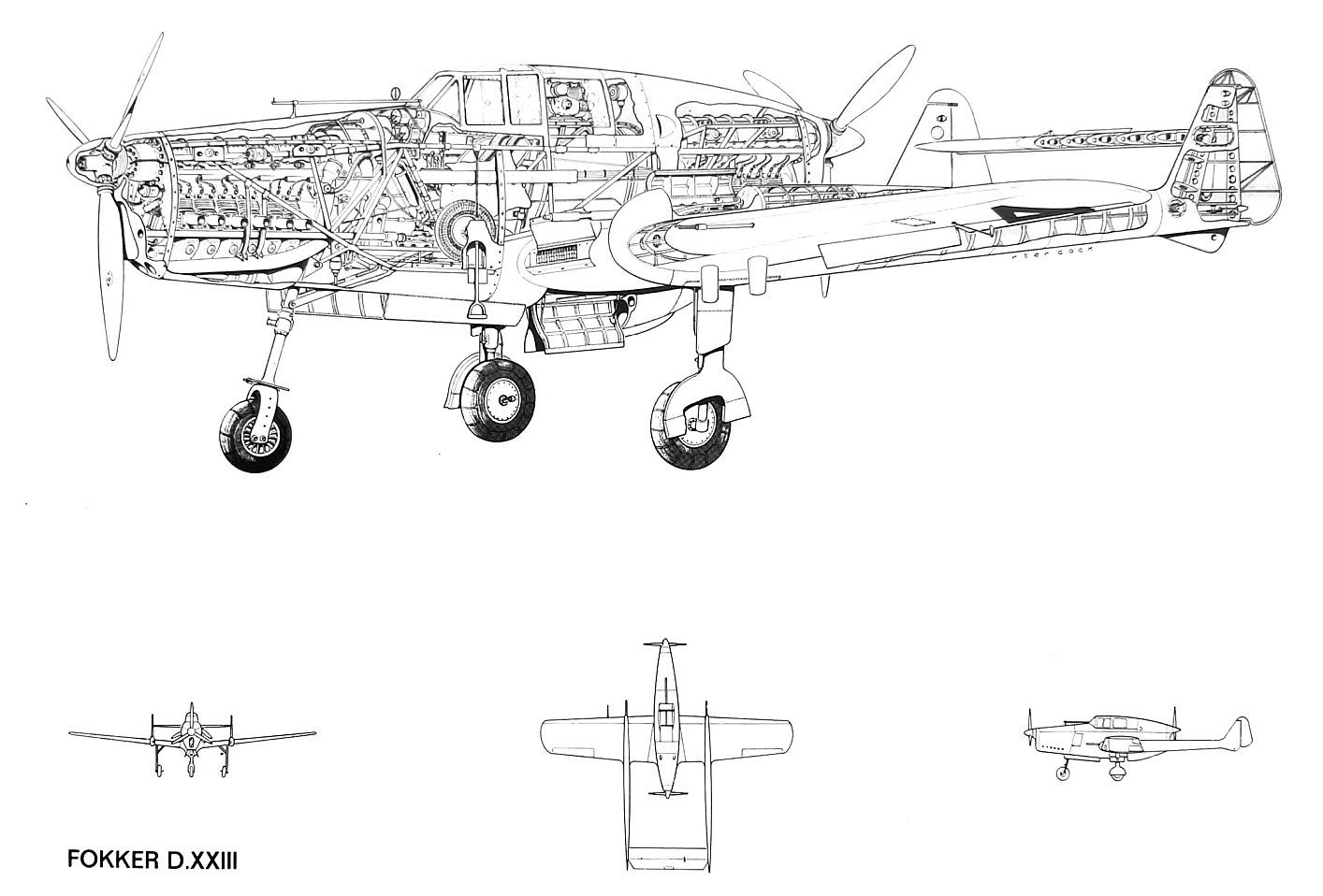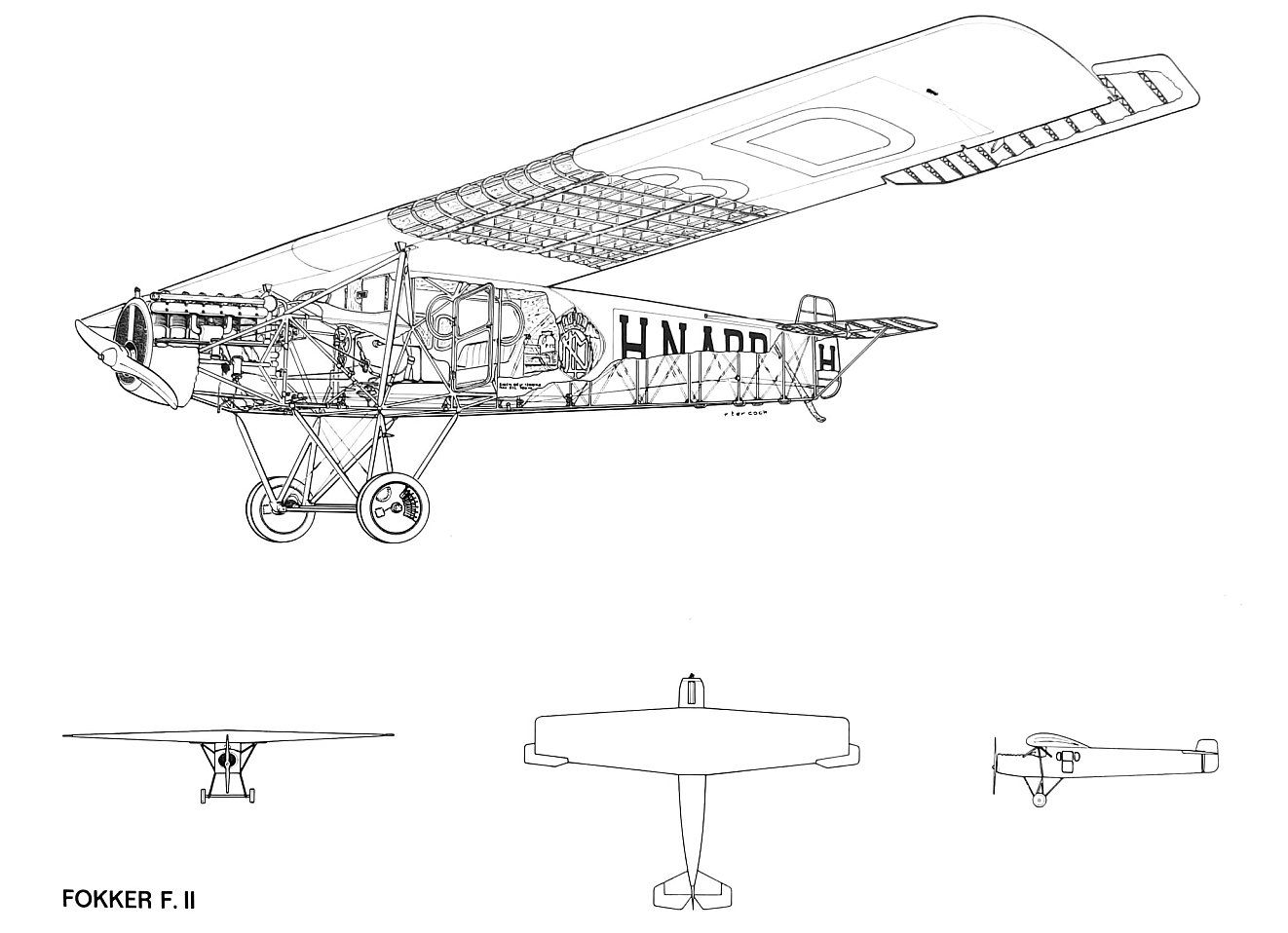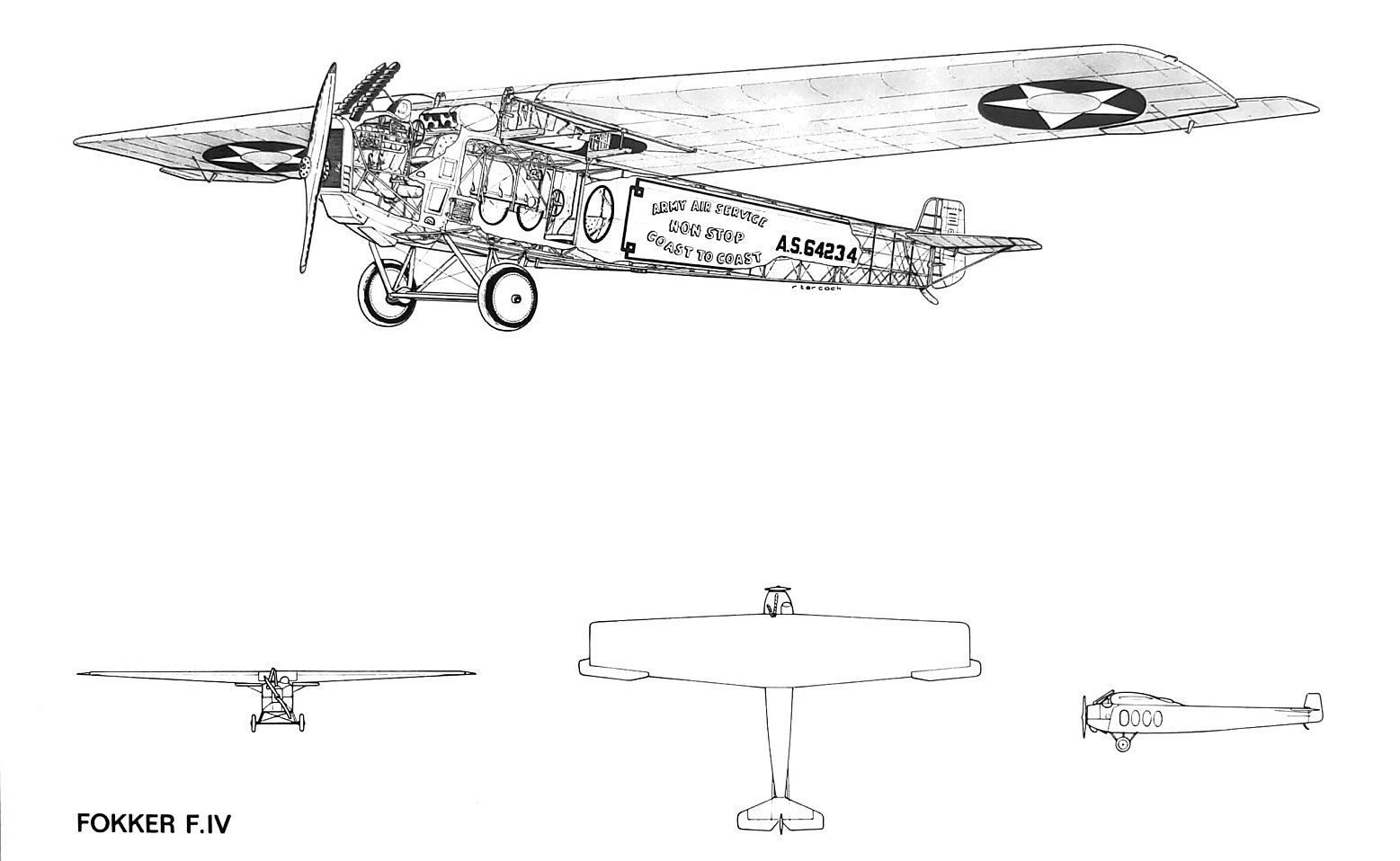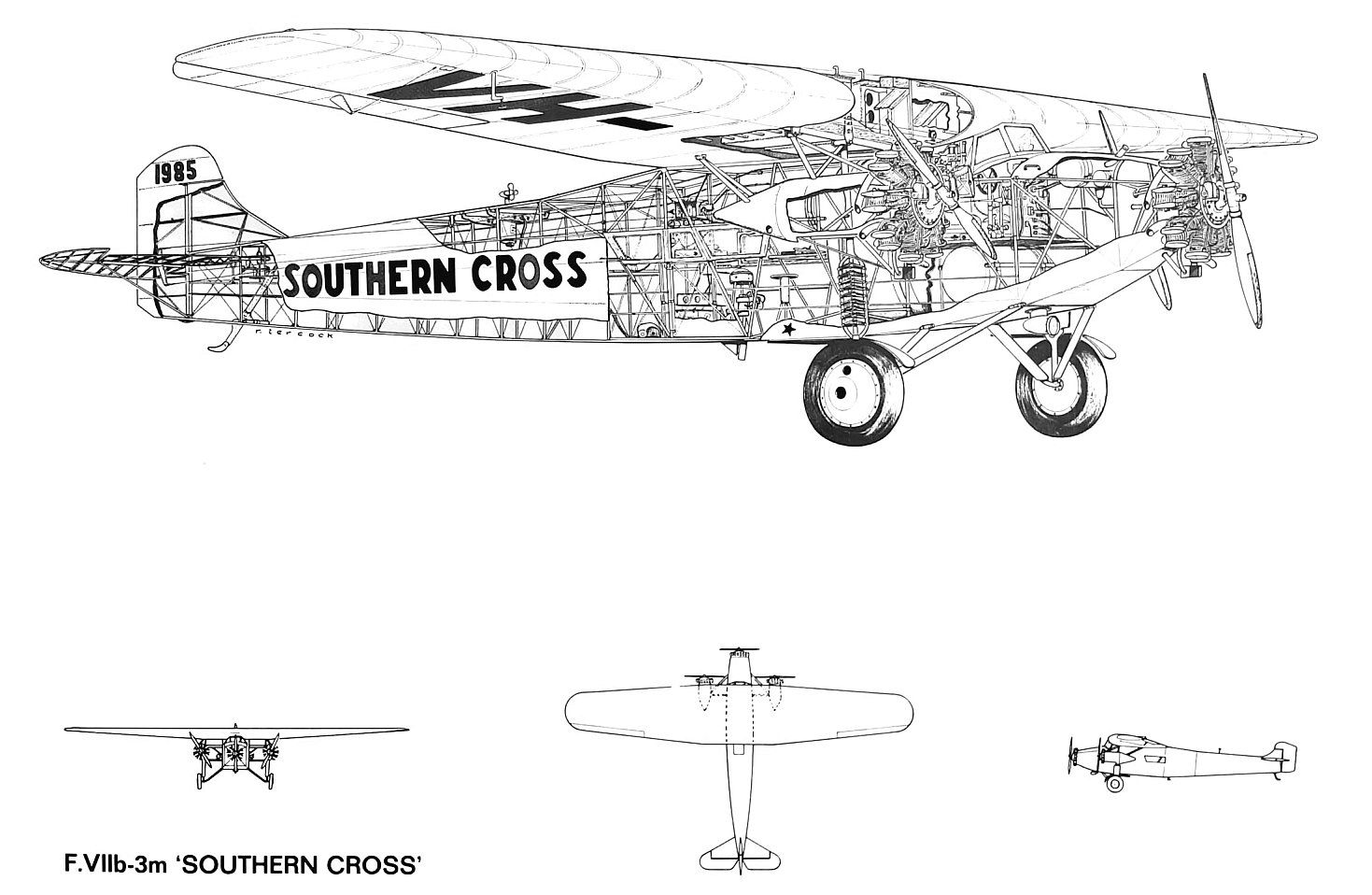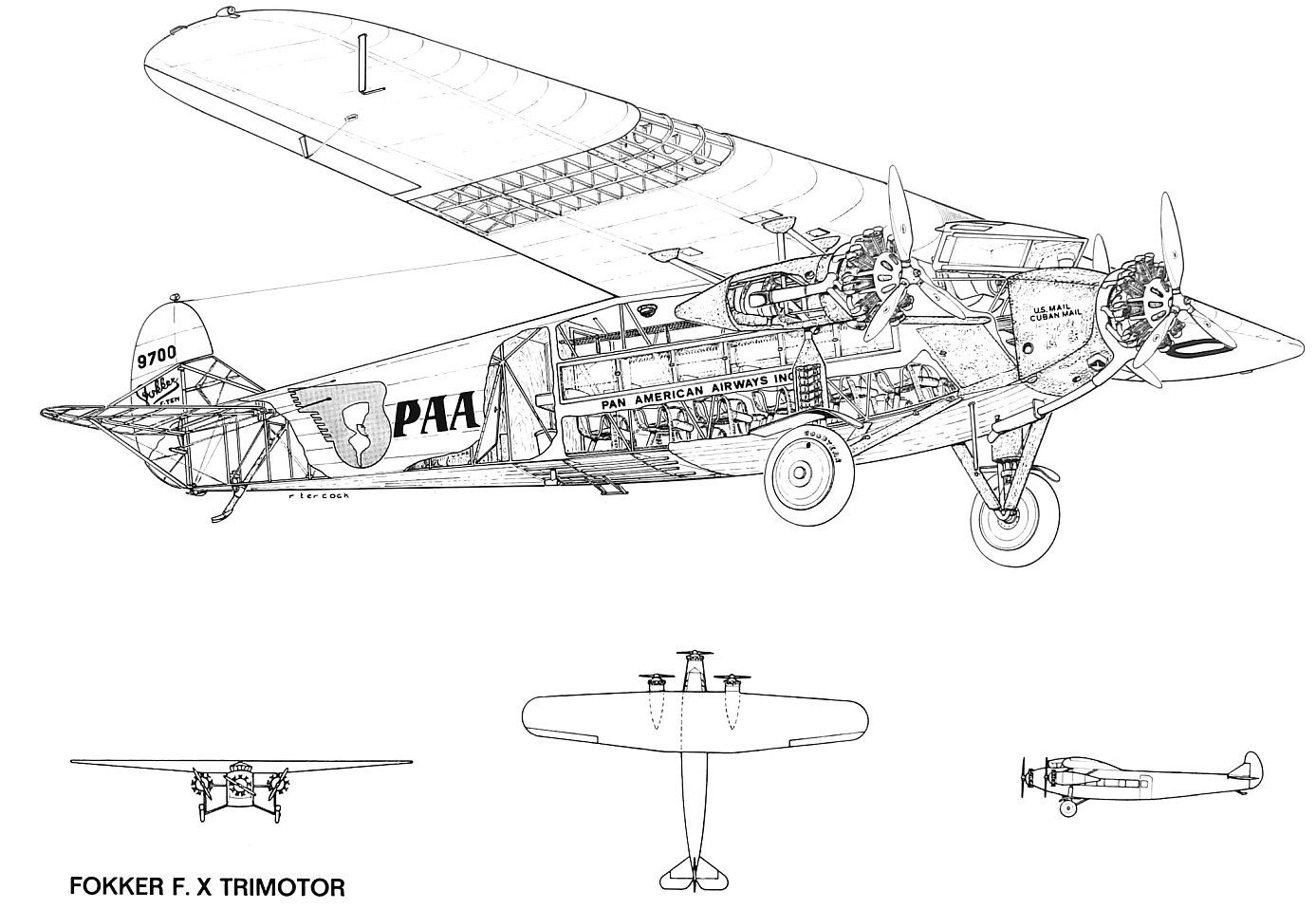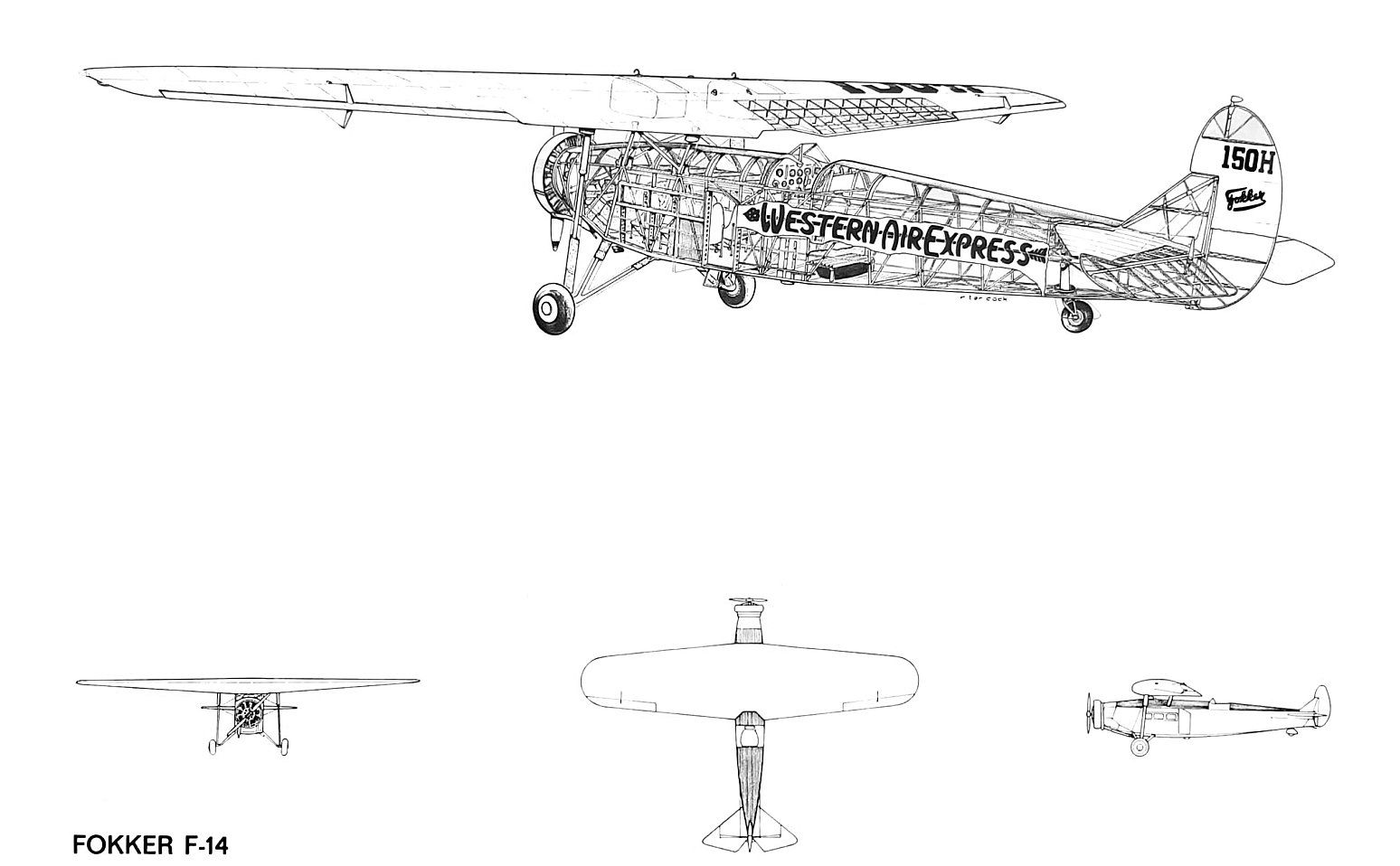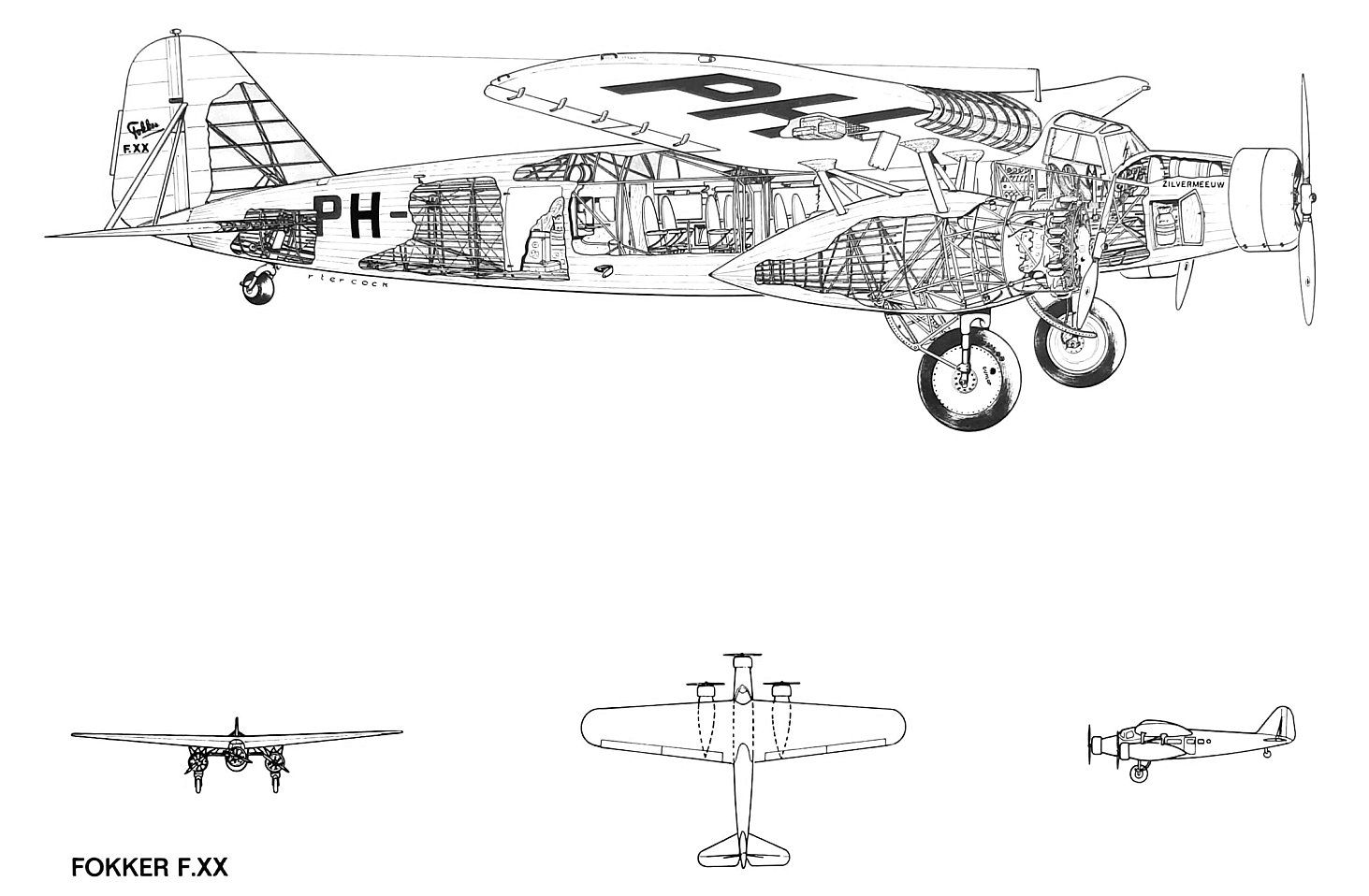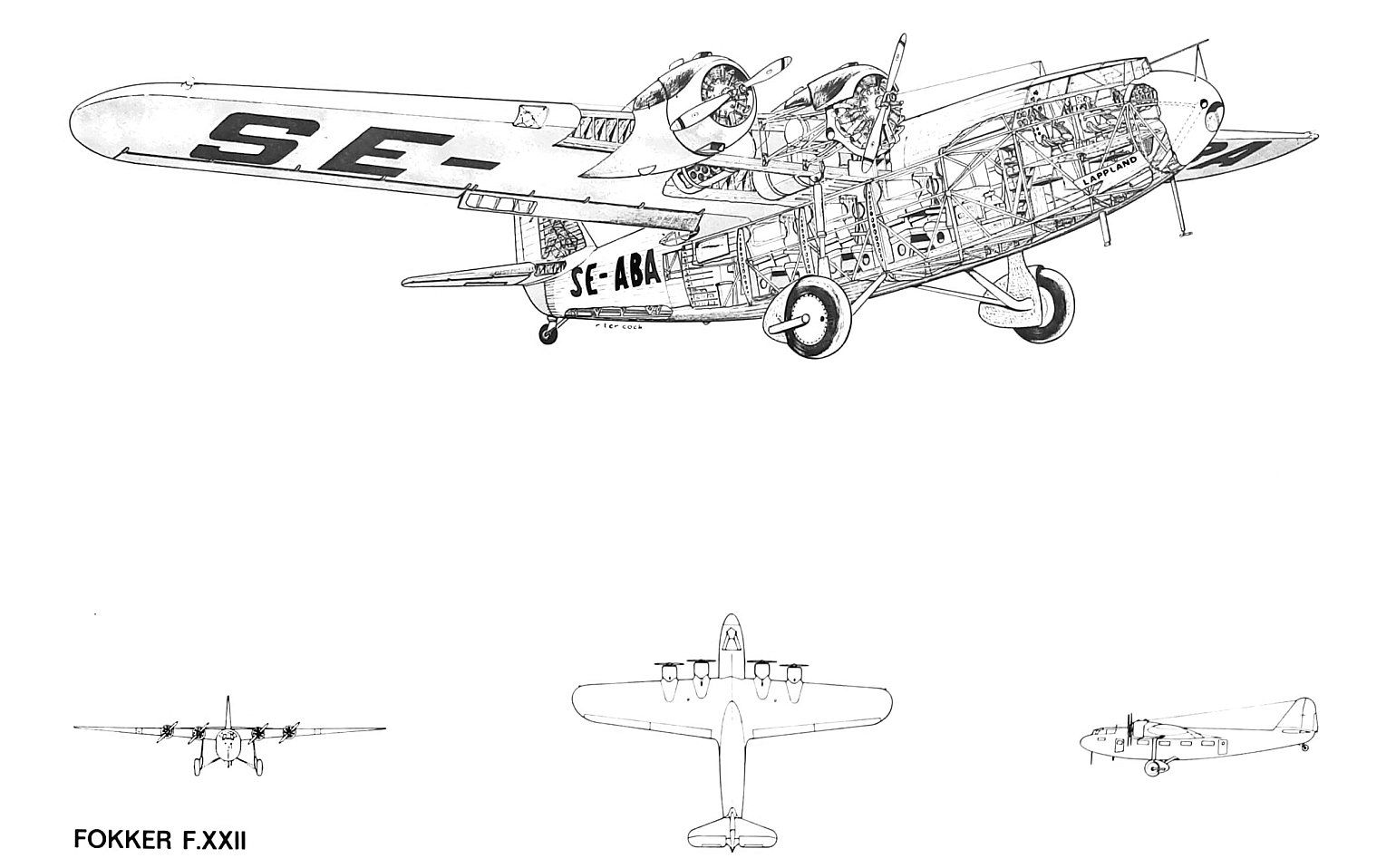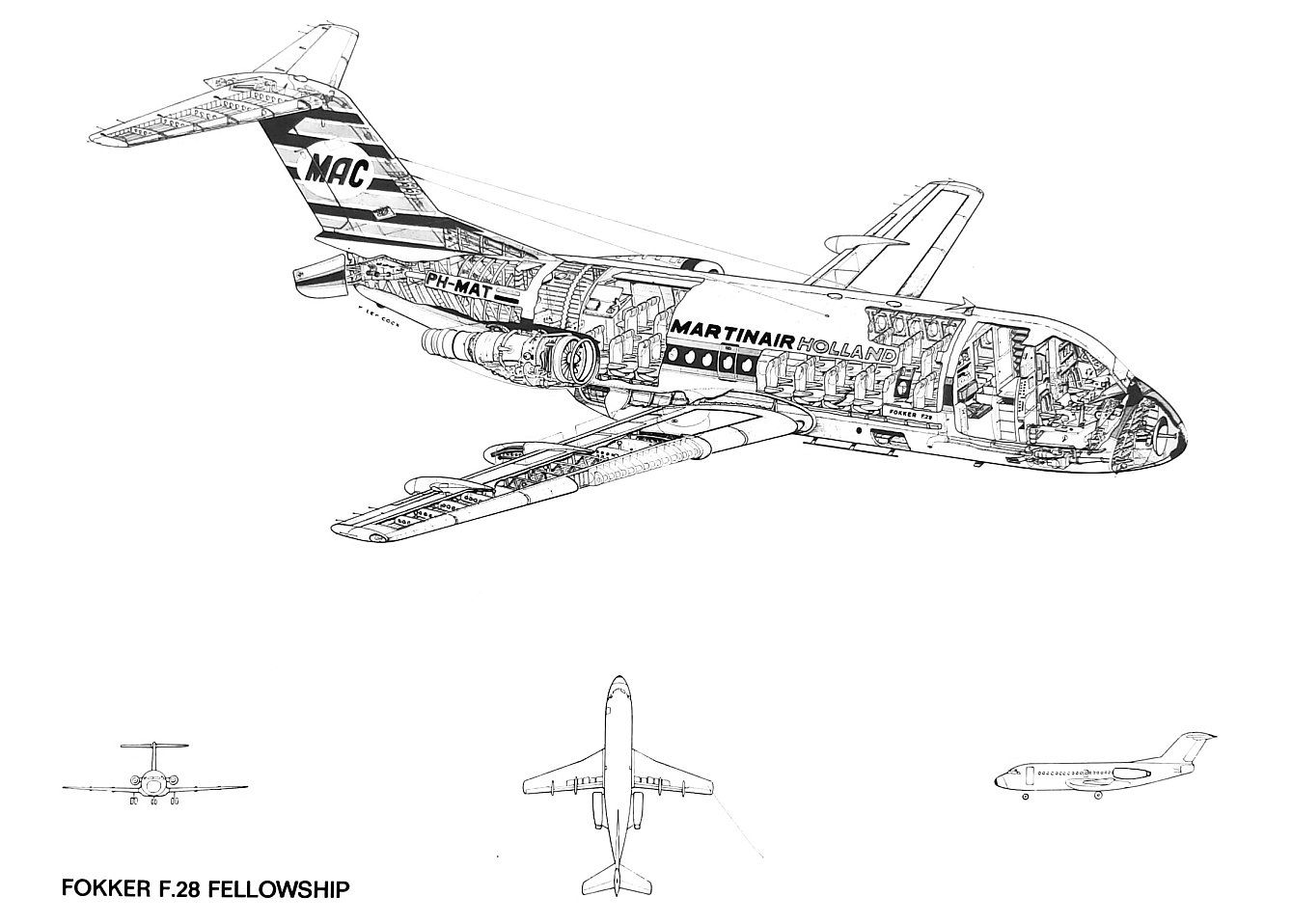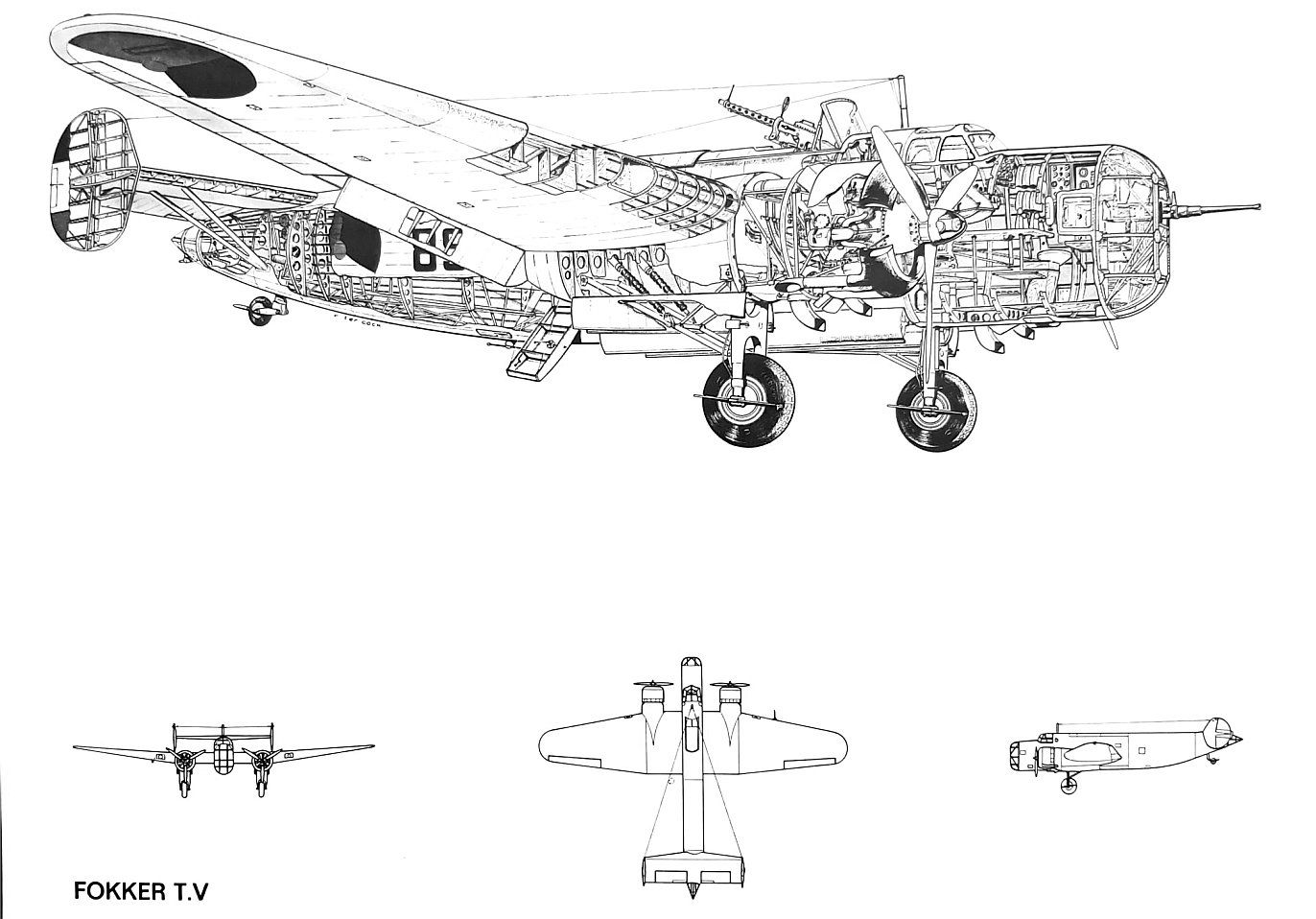Drawings of various Fokker aircraft
Drawings of 48 Fokkers, drawn by R. ter Cock, provided by Dio Roelofs.
The text below is from around 1970, so the situation in the text may have changed.
Click on the photo to enlarge the photo
The Fokker Spin
1910/1911 Young Anthony Fokker got an opportunity to realize his dreams by building his first real aircraft in 1910, when he was at an automobile school in Germany.
The first flying machine was a contraption of wood, steel tube, fabric and wiring, powered with a 50 hp Argus water-cooled engine; it was soon nicknamed "The Spider" (Nr. I.) In its original form it did not have a rudder or ailerons. The two narrow track wheels were between two welded tubular skids under the swept wing. After his partner Lt. von Daum had wrecked it during taxiing, he built an improved "Spider" (Nr. II) with rudder and ailerons and with a wider wheel track and longer skids. On this aircraft Fokker taught himself to fly. On demonstrations he showed the excellent flying characteristics of his automatically stable airoplane.
A third lighter improvement, Spider-version Nr III, did not have ailerons because it was automatically stable (Fokkerpatent DRP Nr. 265515) This type was built in one- and two-seat variants. By covering the wooden fuselage beams by a nacelle, the 1913 Spider became known as the M.1.
Fokker managed to sell several "Spiders"; he also started a flying school at Johannisthal. The original "Spider" was destroyed in the "Zeughaus" in Berlin, during WW II, after Hermann Goring had taken it from Fokker's. A replica which was built in 1936 is now resting in the Aviodome at Schiphol Airport (Now, 2021 in the Avidrome in Lelystad).
The Fokker B-series
FOKKER B.II 1923
Fokker built in Holland four types of flying boats, some with amphibian properties. After the B.I pusher-engined amphibian with retractable wheel was built for the MLD in 1922 (1st flight 18th January 1923), a small three-seat reconnaissance flying boat, the B.II, was developed at Veere and tested for the first time on December 15th, 1923. Its tractor 360 hp Rolls-Royce "Eagle" VIII engine was mounted upon the fabric covered upper wing. The lower wing was of plywood and spruce.
FOKKER B.IV 1928
For the American market the B.IV flying boat was developed in 1928. The cantilever shoulder-wing was entirely of wooden construction, while the fuselage was of an interesting light-metal one. Various interiors could be furnished in the cabin section for executive use. The 525 hp Pratt & Whitney was pylon-mounted on the wing. In the USA the B.IV got the designation F-11. Only one flying boat was built, the rest were amphibians, the F.IVA or F-11A. Some twenty fuselages were built in Amsterdam, but only a few were used. A part of such a fuselage is still to be seen at the Technical University at Delft. In the United States several versions were developed by General Aviation Corp which had taken over the US Fokker assets. The GA-15 series had either two 420 hp P & W Wasp pusher-type engines (FLB-Flying Life Boat) Hornets of 525 hp (known as PJ-1 with the Coast Guard) or tractor-type Hornets (PJ-2).
The Fokker C-series
FOKKER C.1 1918
Reconnaissance aircraft, built by Fokker, were all of the C-type. In the last phase of World War I a two-seat lengthened reconnaissance version was derived from the D.VII biplane fighter. This experimental (Versuchs-) type became known as the Fokker V.38. Although built at Schwerin in small quantities this two-seat observation biplane was never accepted by the German authorities. The C.I, as the type designation was of this experimental V.38, was one of the first types that was built in large quantities by the Dutch Fokker factory in the twenties.
Many C.I's were in service with the armies of Holland (Luchtvaartafdeling), Denmark (Haerens Flyverkorpset), Zwitserland (Fliegertruppe) and in Russia.
The Netherlands Army Air Service (LVA) used fifty six C.I's, and rebuilt another six mil. reg. 488 - 546, mainly powered with 185 hp BMW IIIa water-cooled engines. The Dutch Naval Air Service MLD used twelve C.I aircraft. The rotary 160 hp Oberursel was also used.
In 1929 aircooled 200 hp Armstrong Siddeley "Lynx" and "Mongoose" radials were installed by the LVB at Soesterberg, the maintenance shops of the Army Air Service, and some aircraft featured the
thick low-pressure balloon-type tires that became popular during a certain period, to operate from soft grass fields.
Two C.I's were delivered to Denmark where another three were built at Klovermarken. (mil.nrs. 0-51 - 0-55) The Sowjet Union ordered a total of 42 aircraft; it is possible that many more were built in Russia.
FOKKER C.IV-Series 1923/1924
In 1923 with the C.IV, Fokker created a very versatile type of reconnaissance aircraft which could be delivered with three different wing platforms and a variety of engines.
A relatively fast fighter-recce version, the C.IV-A with a shorter span wing of 12.02 m and a wing area of 34.6 sq.m., the C.IV-B with 12.9 m span and 39.15 sq.m. wing area and the C.IV-C with the long span wing of 14.2 m with an area of 43.5 sq.m., for the reconnaissance and bomber versions.
The prototype which made its first flight in 1923 still possessed the square lines of contemporary machines; it was powered with the then popular Packard "Liberty" engine of 420 hp. The following versions were more streamlined and used the 350hp Rolls-Royce "Eagle VIII" or the 450 hp Napier "Lion".
A total of 139 C.IV's was built by Fokker in Amsterdam.
The C.IV-A recce-fighter was also built for the Dutch East Indies Army Air Service (KNIL-LVA) and became known as the D.C.I. The C.IV-B and -C were delivered to the Dutch LVA (mil.nrs. 547 - 580), Russia, Spain, Italy, Argentina and the United States. In Spain Jorge Loring manufactured a series under license for the army air service. The Argentine Major Zanni flew from Amsterdam to Tokyo in a C.IV which could be fitted with a pair of floats (C.IV-W).
FOKKER C.V-Series 1924/1934
Directly developed out of the versatile C.IV-series the C.V and its different versions was the best sold military Fokker aircraft in the pre-war years.
By using various wings and engines it could be delivered for different military purposes, such as tactical and strategical reconnaissance, and as a fighter-bomber. The following engines were used in the C.V-A,B,C,D and E-types which were subsequently built in the twenties and thirties: 450 hp Lorraine Dietrich, 350 and 450 hp Hispano Suiza, 400 hp Packard Liberty, 250 hp BMW, 450 hp Napier Lion and 450 hp Bristol Jupiter.
In 1925/27 the Dutch Army Air Service acquired many C.V-D aircraft, powered with 450 hp Hispano Suiza water-cooled engines. These were later on re-engined by the 650 hp Rolls-Royce Kestrel. The Workshops of the air force built the C.VI, by mounting a 350 hp HS. The Marineluchtvaartdienst (Naval Air Arm) and the KNIL (East Indies Army) used C.V-C and E versions, the first powered with Lorraine and Hispano, the latter with Napier Lion engines.
By its simple and robust construction the C.V became popular with quite a number of air forces. Bolivia used a few during the Gran Chaco war. Denmark received a batch from Fokker, before taking up licence production in the Klovermarket state factory, where initially 13 aircraft were manufactured. In 1933 13 further C.V-E's were supplied to Denmark and 23 produced under license. KTA (Kriegstechnische Abteilung) in Switzerland received 3 and 3 aircraft in 1927 and 1931 before this type was manufactured under license at Thun; 41 aircraft were built in 1933 and 8 in '34. KTA developed an own version out of the C.V-E, the so-called C-35 of which 80 were produced in 1937 and another 8 in 1942, out of spare parts. In Hungary Manfred Weiss took up license production after having received 3 a/c from Fokker. Both D-and E-versions were built, as W.M. Budapest 9, powered with Jupiters. With the Hungarian-built 870 hp WM K-14 engine the type designation of the C.V was Budapest II or 14. At least 100 aircraft were thus manufactured in this country.
A modified Manfred Weiss version became known as the WM 21 Solyom, squadrons of which were used during WW II.
In the Northern countries, Finland, Sweden and Norway the C.V was manufactured by the state factories in these countries in large quantities. Sweden p.e. received in 1927 and '28 resp. 2 and 6 aircraft for the Flygvapnet, while a further seven and thirty-nine were supplied by the state factory in '29 and '39/'40.
One particular Swedish C.V became well-known, when Capt. Einar Lundborg rescued the Italian General Nobile in it, after the "Italia" catastrophy in the Arctic region in June 1928. Officine Ferroviarie Meridionali in Italy built the C.V-E, as Romeo Ro. 1, under license for the Reggia Aeronautica.
FOKKER C. VIII -W 1929
Though the C.VIII-W was only built in a modest series of nine aircraft for the Marineluchtvaartdienst, the Naval Air Arm, this sturdy parasol three-seat reconnaissance seaplane saw a long and honorable life in the Netherlands. This floatplane was in fact a navalized version of the three-seat recce plane in use with the LVA, the Netherlands Army Air Service.
The armament consisted of one fixed and two movable machine guns and it could carry either bombs or a torpedo underneath the fuselage, between the struts of the float undercarriage. The first flight of the 450 hp Lorraine-powered C.VIII-W took place on 15th November 1929. At the outbreak of WW II five aircraft managed to escape to England in May 1940.
FOKKER C.X 1934
To replace the aging C.V-D and -E reconnaissance aircraft a modern and faster fighter bomber was developed in 1934, the C.X. The prototype which was exhibited at the Paris Air Show was powered with the new Hispano-Suiza "moteur-canon". This particular aircraft, PH-ALX later on went to the air force as no. 750.
The first flight with the 625 hp (later 650 hp) Rolls-Royce Kestrel C.X for the LVA, the Dutch Army Air Service took place on October 9th, 1934. A total of 20 aircraft was delivered to Soesterberg airbase. (mil. nrs. 701 - 720). The C.X was also used in the former Dutch East Indies. (F.C.X-453 etc.) Originally the C.X had open cockpits for pilot and observer; at a later stage a sliding plexiglas roof was installed. Another version of the C.X was powered with the 925 hp Bristol "Pegasus" radial engine. Four of these were delivered to Finland where another 30 were built in 1938 and 5 in 1942 by Valmet 0/Y under license.
A total of 36 C.Xs was built in Amsterdam.
FOKKER C. XI-W 1935
In 1935 a two-seat naval reconnaissance and light bomber biplane on floats, the C.XI-W, was developed for naval use from shore bases or catapult-equipped cruisers. The Air Arm of the Dutch Navy, the Marineluchtvaartdienst, purchased fourteen aircraft of his type, powered with 775 hp Wright "Cyclone" engines.
With the prototype tests were performed from a catapult installation in Northern Germany. Although the C.XI-W originally had open cockpits for pilot and observer, the series was fitted with a perspex sliding roof, similar to that used on the C.X.
Most of the MLD series were shipped to the former Dutch East Indies, prior to the Pacific War. Some aircraft which were used on board of HM cruisers were camouflaged in an unusual zig-zag pattern.
The Fokker D-series
FOKKER D.VII 1918
The D.VII fighter was one of the most famous aircraft at the end of WW I. An estimated 1350 aircraft of this type were built by Fokker at Schwerin, while Albatros manufactured some 923 and OAW some 826. In Hungary MAG built another thirty D.VII aircraft.
After the war many army air services used this type for a long time, such as the Netherlands, the Dutch East Indies, Poland, the USA, Switzerland, Sweden, Russia, Denmark, Belgium, Italy and Finland. The original 160 hp Mercedes or 185 hp BMW engine wassomtthp BMW, the 230 hp Siddeley Puma, or as in the USA for the Packard Liberty or Hall-Scott engine.
The Dutch Army Airservice, as well as the Naval Air Arm used the D.VII fighter for a long period, until they were replaced by a more modern fighter type.
FOKKER PW-7 1923
Based on the experience, gained with the D.IX biplane and the D.X monoplane fighters, the slender D.XI sesquiplane fighter, powered with a 300 hp Hispano-Suiza water-cooled engine was developed. Two D.Xi's (mil. reg. 641, 642) were delivered to the Swiss Fliegertruppe and a series was supplied to the Rumanian Army. Powered with the 440 hp Curtiss D-12 engine, three D.XI aircraft were procured by the U.S. Army Corps for evaluation. These aircraft received the American military designation PW-7 and were registered A.S. 68580, 68581, 68582. All had a modified undercarriage without horizontal axle. The first PX-7 used a V-strut between the wings, while the other two had an N-strut; these aircraft became known as Fokker XPW-7A.
FOKKER D.XIII 1923
The D.XIII sesquiplane that made its first flight on September 12th, 1923, was an extremely fast and manoeuvrable, fighter that was developed out of the D.XI and D.XII. It was powered by a 350/450 hp Hispano Suiza or a 450 hp Napier "Lion" XI engine.
Fokker's test pilot Mr. Grase established four new world speed records in an aircraft of this type. A little known, though very interesting role was played by this sturdy fighter aircraft in the German pilots training which was done in secret in Russia. When in 1923 the German Federal Government had plans to encounter the marching in of French troups in the Ruhr-area with arms, a hundred D.XIII fighters were ordered with Fokker's through the German financier and industry tycoon Hugo Stinnes. Because these aircraft could not be delivered in time, only fifty were accepted through Stinnes, to be used for the pilot training which was set up at Lipezk in Russia, after a secret agreement between Germany and Russia in the period 1925 - 1933. The aircraft were shipped per s.s. "Hugo Stinnes 4" from Stettin to Russia. At Lipezk hundreds of aspirant-pilots had their training, after having crossed the border as tourists. These would eventually form the nucleus of the Reichsluftwaffe which was formed in the Nazi-period. Also C.I and C.IV (55 aircraft) were delivered to Russia.
FOKKER D.XVI 1929
In order to re-equip the aging D.VII fighter aircraft of the Dutch Army Air Service (Luchtvaart Afdeling LVA) Fokker designed in 1929/30 a sturdy sesquiplane, the D.XVI single-seat fighter, according to military specification. The 460 hp Armstrong Siddeley "Jaguar" radial engine was chosen to power the LVA D.XVI's. During extensive testing the protOtype was modified with a Townend ring around the engine and with an enlarged exhaust pipe, running along the fuselage. A batch of fifteen aircraft were delivered to Soesterberg airfield, bearing mil.reg.nrs. 275 - 289. On June 8th, 1933, 1st Lt. Jhr. H.J.M. van Asch van Wijck reached a record altitude of 9,587 m (31,445ft) in a D.XVI. Famous aerobatic pilot Jhr. Sandberg used a specially modified D.XVI,
powered with a Bristol "Mercury" with three-bladed air screw.
One "Jaguar"-powered D.XVI was sent to Italy for evaluation by the Reggia Aeronautica, but no order was given. This aircraft eventually went to China, where it was tested by the army air service of the Chinese at Hankow.
Four Gnome Rhone "Jupiter"-powered D.XVI's were built for Hungary and delivered under civil registration (PH-AGS - PH-AGV). Hungary was not allowed to have any military aircraft in service, because of the Peace Treaty conditions. Thus aircraft flew under civil disguise as mailplanes or trainers. The first flight with this version was made on March 12, 1930.
A water-cooled Curtiss "Conqueror"-powered D.XVI, mil. reg. F-32, featuring a slightly modified undercarriage, was built for the KNIL, the army air service in the Far East.
A total of twenty-one D.XVI aircraft were built by Fokker in Amsterdam.
FOKKER D.XVII 1931
The Curtiss "Conqueror" powered D.XVII, reg. F-32 was the prototype of a faster development of the D.XVI sesquiplane. It was hoped that the KNIL, the Dutch East Indies Army Airservice would order this fighter, but an order was received instead for the LVA at Soesterberg. Eleven D.XVII's were delivered (201 - 210), equipped with various engines, such as the 580 hp Rolls-Royce "Kestrel" IIS, the Lorraine "Petrel" and the Hispano Suiza Xbrs. A projected canopy-enclosed cockpit version was cancelled at the design stage. De price of this fighter, without engine was f 21.150,-(this compared to the 10-20 millions of a modern interceptor fighter).
FOKKER D.XXI 1936
The D.XXI single-seat which succeeded the successful fighter types that were developed between the two world wars, such as the D.VII, D.X, D.XI, D.XII, D.XIII (and the single D.XIV), D.XVI and D.XVII, would be the last fighter type that was manufactured in quantity.
Though orthodox of design, steel-tube fuselage and wooden wing, this rugged fighter saw more action during wars than other Fokker aircraft. Originally designed to a specification of the Royal Neth. East Indies Army, the prototype, powered by a 645 hp Bristol "Mercury", made its first flight on March 27th, 1936, at Welschap airfield, near Eindhoven.
For the Luchtvaartafdeling LVA thirty-six planes were built. The D.XXI attracted the interest of other airforces, amongst others Finland which country ordered seven aircraft and which acquired the licence rights for the State factory at Tampere, Valtion Lentokonetehdas. In 1939 thirty-five Bristol "Mercury"-powered D.XXI's were manufactured in Finland, followed by an additional fifty in 1941 and five in 1944, these powered by 1,050 hp Pratt & Whitney "Twin Wasp" Junior radials. Denmark followed suit with an order for three D.XXI's and a licence agreement for the State factory at Klovermarken. At the outbreak of war Nr. 2 eskadrille of the Danish airforce consisted of D.XXI fighters.
Little is known about the fact that Republican Spain obtained the licence rights for this type. Fuselage production in a factory in Catalunia came to an end when the republican army surrendered. During the hostilities in Holland D.XXI fighters of the 1st, 2nd and 5th Fighter Group fought a gallant battle against an overwhelming Luftwaffe. The Finnish used their D.XXI's in the winter war against Russia and this sturdy and stable gun platform performed an extremely good job with Squadrons HLeLv 32, 24 and TLeLv 12.
FOKKER D.XXIII 1938/1939
On the Paris Aircraft Exhibition in November 1938 the revolutionary D.XXIII twin-tailboom fighter with two Walter Sagitta 528 hp engines with pusher and tractor propellers attracted much interest.
It was the first Fokker fighter with retractable three-wheel undercarriage with nosewheel which could be regarded as an experimental prototype for a heavier fighter with two Daimler Benz DB 600, JUMO or other more powerful engines. Fokker's chief-test pilot Gerben Sonderman made the first flight with the X-4 registered D.XXIII in May 1939. The prototype was damaged during the airaids on Schiphol in May 1940.
The Fokker F-series
FOKKER F.II 1919
The Fokker F.II was in fact the world's first commercial aircraft, designed to carry passengers comfortably in an enclosed cabin. Realizing that after World War I aircraft would play an important role in transportation, Anthony Fokker developed, under supervision of Reinhold Platz, the experimental V.45 high-wing monoplane. Originally the fuselage would accommodate five passengers in open cockpits. This would have become the F.I. The wing which was already manufactured was used for the F.II which featured an enclosed cabin. In its experimental stage this prototype was mentioned as V.45, but became known as the Fokker F.II. Fokker's friend and pilot Bernard de Waal flew it from Schwerin, where it was built, to Holland. KLM Royal Dutch Airlines acquired two F.II aircraft (H-NABC, H-NABD). SABENA, Balair, Deutsche Aero Lloyd, Deutsche Luftreederei and DERULUFT started also with this type which were built at Staaken in Germany. Like most Fokkers the F.II consisted of a welded steeltube fuselage which was fabric covered, and a cantilever wooden wing of rugged construction. Either the 185 hp BMW or the 240 hp Armstrong Siddeley Puma water-cooled engines were used.
FOKKER F.III 1920/1921
The F.III was a direct development of the first commercial aircraft Fokker had built, the F.II. The larger F.III was a very successful type which saw service with quite a number of young airlines in the early twenties. It was in fact only after WW I that commercial aviation started to develop in Europe and in the United States.
In April 1921 the 185 hp BMW-powered prototype F.III made its first flight. Royal Dutch Airlines KLM used a fleet of fourteen aircraft of this type, powered with 240 hp A.S. Puma, on their expanding network and scheduled services which were maintained in Europe.
The Hungarian airline MALERT (Magyar Legiforgalmi R.T.) used a number of F.III which obtained a remarkable 100% safety and 98% regularity factor for six years. The Swiss BALAIR company started in 1926 with F.III's, after having received a number from KLM. Det Danske Luftfartselskab acquired a batch of F.III aircraft that were built under a licence agreement in Germany at Staaken. Fokker in Amsterdam, delivered four aircraft to DERULUFT (Deutsch Russische Luftreederei) for flights between Berlin and Moscow. The depicted drawing shows one of these DERULUFT F.III's in Danzig colours (now Gdansk). German-built F.III aircraft were in service with Deutsche Luftreederei, Aero Lloyd, Stid-Deutsche Aero Lloyd and later Lufthansa.
Some F.III's found eventually their way to A.T.A. in Italy and to the United Kingdom. One former KLM aircraft, H-NABV, is reported to have flown in Australian New Guinea in December 1930.
Two aircraft were sent to the United States in the early twenties. One of these was flown by Mr. Noel Wien, founder of Friendship-operator Wien Alaska Airlines (now Wien Consolidated).
FOKKER F.IV (T-2, A-2)
In 1921 the high-wing F.IV transport monoplane was developed at Veere, where Fokker had established a workshop in the former naval hangar. Nowadays this type would be called a stretched version of the F.III, designed to meet United States requirements. The cabin accommodated eleven passengers in two separate compartments, each with their own entrance door. The front cabin could house seven, the rear one four passengers. Two F.IV's were built in Holland and shipped to the Unites States by the end of 1921. After demonstrations to civil and military authorities both aircraft were bought by the U.S. Army Air Service and evaluated under the designation T-2. One aircraft was converted into an ambulance plane, known as the A-2. The remaining T-2 became famous by its non-stop coast-to-coast flight that Lt. McReady and Lt. Kelly made, after it was equipped with long-range tanks. After having established an official endurance record of 36h 5,3 min over Dayton in October 1922, the non-stop flight from New York to San Diego was made on 2 - 3 May, 1923. The 4,586 km distance was covered in 26h 51 min. This aircraft, registered A.S.64233, now rests in the National Air Museum of the Smithsonian Institution in Washington, DC. Both F.IV's were powered by a 400 hp Packard Liberty twelve-cylinder water-cooled engine.
FOKKER F. VII 1924
The F.VII which was built in 1924 contributed much to the development of civil aviation in Europe, as this type made the first mail flight from Amsterdam to Indonesia. H-NACC is still living in the hearts of many old-timers. Four more F.VII's were built for KLM, H-NACJ, CK, CL and CR. Powered with a Rolls-Royce Eagle, except for CR which had a 450 hp Napier Lion, these aircraft served for many years. CC was re-engined with a 400 hp Bristol Jupiter lateron, while CJ and CR received a 480 hp Gnome Rhone Jupiter. CK was finally sold to the United States and CR saw service with Pacific Aerial Transport in New Guinea, before it was resold to Mandated Airlines, where it was used until 1936.
FOKKER F.VIIa 1925
A direct descendent of the rugged, but rather square F.VII was the aerodynamically much cleaner F.VIIa which featured a tapered wing with inset ailerons, and which had a single-strut undercarriage with streamline-covered shock-absorbing rubbercord.
The prototype, temporary registered H-NACZ, flew for the first time on March 12 th, 1925, prior to its shipment for demonstration in the United States. This aircraft still had the water-cooled 400 hp Packard "Liberty" 12-cylinder engine which powered its predecessor. Various types of aero-engines could, however be used.
It was actually the first commercial aircraft in the world to be powered with an air cooled radial engine.
The F.VIIa was a successful aircraft of which a total of 42 were eventually built in Amsterdam. Beside the four aircraft that were sent to the USA, all others were used by European companies, such as KLM (eleven), Balair (three), Det Danske T,uftfartselskab. Lot Polski Lotni CP....French CIDNA and STAR, Czechoslovak CLS and CSA, Avio Linee Italiane, Sabena, Malert/Hungary.
KLM's F.VIIa's were registered as H-NACT (destroyed on May 10th 1940 at Schiphol), H-NADF, G, H, J, K, 0, N, P, Q and R. H-NADP carried millionaire van Lear Black to the Far East on the first long-range charter flight. This particular aircraft was lateron rebuilt as H-NADR, then became PH-OTO, PH-ALY, OY-DEV and finally ending with the Finnish Airforce as FE-2. Two of the S%% i» F.Vila sun i‘ ed: C11-157 became HB-LBO and finally given to the Bern postal museum in 1948; CH-158 came back to Holland after seeing service in Denmark and Sweden, and now rests in the Aviodome at Schiphol-Central Airport.
FOKKER F.VIIa and b-3m 1924/1929
The trimotor F.VII series was the most successful Fokker transport that was built between the two world wars. In order to participate in the Ford Reliability Tour in America Fokker had the second F.VIIa single-engined monoplane which was built in Amsterdam modified into a trimotor (c/n 4900), a development which was performed in seven weeks. Anthony Fokker established a reputation with this type, by winning this Tour. This particular aircraft was lateron used for Byrd's Arctic Expedition, and became known as the "Josephine Ford". It is now preserved in the Ford Museum in Detroit. A number of F.VIIa-3m's were used in the USA. One was used for the mailflight to Batavia, piloted by Lt.Koppen (H-NAEA Postduif), finally serving as nr. 803, together with 801 and 802 with the LVA at Soesterberg. The F.VIIb-3m had the larger span wing. This version became one of the outstanding transport aircraft of the pre-war era. More of them were manufactured than any other Fokker transport. Because of the larger wing a larger payload could be carried. A variety of engines could be installed, making it very flexible. With the Fokker F.VII trimotor many history-making flights were performed, not only with the airlines. Byrd used one for his Arctic expedition; Amelia Earhart (NX 4204) flew as the first woman across the Atlantic. The name of this aircraft was FRIENDSHIP. Sir Charles Kingsford Smith performed his epic-making flights across the Pacific and Atlantic with this trimotor, the "Southern Cross". It rests now in the K.S. Memorial in Brisbane.
Many airlines used the F.VIIb-3m, such as KLM, KNILM, Avio Linee Italiane, CLASSA, CIDNA, Balair, Swissair, Air Orient, SABENA, LOT, CSA, CLS, Panam, Japan Air Transport, Ad Astra Aero, STAR and others. SABCA in Belgium manufactured 28 Titan-powered aircraft of this type. 18 were built by Plage & Laskiewicz in Poland, 14 by AVIA in Czechoslovakia, 13 in England by A.V. Roe (AVRO Ten) and some in Italy by Officine Ferroviarie Meridionali. Eventually many of these aircraft found their way to other airlines and operators.
FOKKER F.VIII 1927
In 1927 the first twin-engine commercial aircraft was designed by Fokker, the F.VIII, prototype of which flew on June 25th, '27 (Reg.H-NADU). The cabin in the fabric-covered steel tube fuselage could accommodate 12 - 15 passengers. The rounded nose-section could be hinged to get access to the freight compartment in front of the cockpit. KLM Royal Dutch Airlines used seven F.VIII aircraft, registered H-NADU, AED - AEI. Some were sold abroad some years later, such as H-NAEG (PH-AEG) which went to A.B. Aerotransport as SE-AEB "Jamtland" first and which finally entered service with the Swedish Flygvapnet. H-NAEI (PH-AEI) went to British Airways as G-AEPU, then to Sweden as SE-AHA and finally to the Finnish airforce, as a military transport. The latter was originally powered with two 480 hp Gnome Rhone Jupiter VI radials. When in service with KLM these engines were replaced by Wright Cyclones with Townend rings and eventually with Pratt & Whitney T1D1 engines. Some F.VIII were modified by building the engine nacelles in front of the leading edge of the wing, in stead of underslung. One F.VIII was supplied to Magyar Legiforgalmi Reszv. (MALERT) as H-MFNA with four-bladed propellers. Two were subsequently built under licence by Manfred Weiss in Budapest. One of these aircraft featured a typical "bomber"-type nose; because Hungary was not allowed to build military aircraft, these F.VIIIs were civil registered (Viz D.XVI and C.V-E).
FOKKER F.IX 1929
In 1929 a larger trimotor airliner, the F.IX, was developed, to replace the F.VII-3m. In the original version this type was powered with three 480 hp Gnome RhOne Jupiter engines. It became known as the "short-nose" F.IX. (reg. PH-AGA). Seventeen passengers were comfortably seated in the cabin. A year later two 650 hp Pratt & Whitney Hornet T1C1 and a 650 hp Wright Cyclone were installed, necessitating a longer nose for mounting the centre engine. (reg. PH-AFK). At the 1930 Paris Air Show this version won the "Prix d'Elegance et de Contort". Both aircraft were used by KLM.
A licence was sold to the Czechoslovak aircraft factory AVIA in Prague. This firm built two 635 hp Walter Pegasus IIM-2 powered F.IXD airliners for CSA, while a number of a special bomber version, known as the F-39, was manufactured for the Czech and Yugoslav airforces.
FOKKER F-10 1927
Developed from the F.VII trimotor Fokker Aircraft Corp. designed and built the F-10, a heavier trimotor, accommodating 12 passengers, for the American market. Soon this F-10 Trimotor was fitted with a larger wing and lengthened fuselage for 14 passengers, becoming known as the "Super-Trimotor" or F-10A. The F-10 was powered with three Wright J-6 engines of 300 hp; the F-10A had three 425 hp Pratt & Whitney radials. Of the F-10 seven airliners were built (a/c nr. 1000 - 1006), being delivered to Western Air Express„ Shell, Richfield Oil. Some 60 F-10A were manufactured as airliner at Fokker's Hasbrouck Heights factory in the USA. The F-10 became known as C-5 with the U.S. Army Air Service, and as RA-4 with the U.S. Marines. The C-7A was the military version of the "Super-Trimotor". As an experiment a twin-engined bomber version was developed, but never sold to the military authorities.
FOKKER F.XII 1930
In 1930 the prototype of the trimotor F.XII registered PH-AFL was developed to meet KLM's specification for a transport aircraft smaller than the F.IX, but larger than the F.VIIb-3m. It was powered by three 425 hp Pratt & Whitney Wasp C engines and could accommodate sixteen passengers and a crew of two.
On October 1st, 1931, KLM introduced the F.XII on scheduled service on the Amsterdam-Batavia line.
Eleven F.XII trimotors were built by Fokker, being PH-AFH, AFL, AFU, AFV, AID, AIE, AIH, AII, AIJ for KLM, PK-AFH, AFI for KNILM, SE-ACZ for the Swedish AB Aerotransport. Two aircraft were manufactured for Det Danske Luftfartselskab by Orlogsvaerftet in Copenhagen as OY-DIG, DAJ.
KLM sold eventually their F.XIIs to a.o. Air Tropic and British Airways. Four were finally sold to Spain during the civil war.
FOKKER F-14, F-14A 1929 The 7 - 9 passenger F-14 monoplane with its distictive positioning of the wing above the fuselage and its open cockpit, aft of the passenger cabin, differed considerably from the normal Fokker commercial types. The fuselage top was of corrugated light metal. The F-14 was powered by a 525 hp Pratt & Whitney Hornet radial engine. The F-14A had the more powerful 575 hp P&W Hornet built in.
Aircraft of this type were delivered to Western Canada Airways, Western Air Express (later TWA) and to Costa Rica. With the U.S.Army Air Service the F-14 became known as the Y1C-14. Used as military transport and as an ambulance plane, it was flown under the designation C-14. Versions with 575 hp Whirlwind and P & W Hornet became known as Y1C-14A and C-14B transports.
FOKKER F.XVIII 1932
The F.XVIII trimotor which was built in 1932 and of which five were supplied to KLM, was powered originally with three 420 hp Pratt & Whitney Wasp C engines. For KLM's European network the F.XVIII could accommodate 13 passengers; on the Far East route four passengers and the wireless operator and navigator were housed in the cabin. The five aircraft were registerd PH-AI O, P, Q, R, S of which the Pelican and the Quail became famous by their long-distance mail flights. Q en R were sold to Czechoslovakia (CLS) and Q ending up in Palestina in 38/39. The Pelican disappeared into Spain after having been sold to Air Tropic in 1936.
FOKKER F.XX 1933
The F.XX trimotor which started test flying in 1933 differed in many respects from the earlier trimotors Fokker had built. The fuselage was much more streamlined and had an oval section and the main undercarriage could be retracted manually into the large lower-slung nacelles. The only aircraft built of this type, PH-AIZ Zilvermeeuw, was used by KLM as a twelve-seat airliner with a crew of three. The original three 640 hp Wright Cyclone R-1820F with broad cowlings, were later changed for the 690 hp F2 version. Though it was intended to be used for the special Christmas mailflight to the East Indies, engine trouble necessitated F.XVIII Pelikaan to perform this high-speed mail flight. In October 1936 the F.XX was sold to Air Tropic; painted in camouflage colours it disappeared across the Pyrenees into Spain during the civil war.
FOKKER F.XXII 1935
The large four-egined F.XXII, built in 1935, followed the still larger F.XXXVI of 1934 which was at that time the biggest commercial aircraft in the world. The F.XXII was powered with four 525 hp Pratt & Whitney "Wasp" radial engines and it could transport twenty-two passengers in its broad fuselage. A total of four F.XXII's was manufactured, three of which went to KLM and one to the Swedish airline A.B. Aerotransport. In 1939 two KLM F.XXII's were acquired by Scottish Aviation, just before outbreak of war. The Royal Air Force and the Royal Navy put these aircraft into service for crew training, as well as for crew-ferrying. Until July 1941 these giant aircraft were used for air navigation training and over half of the air observers/navigators of the RAF, up to the most critical period, received their training on these aircraft. After the war the only surviving F.XXII was used by Scottish Aviation for flights between Prestwick and Belfast and for pleasure flights. In 1953 it was eventually scrapped owing to lack of museum space and funds in the Netherlands, after it was offered to Fokker.
FOKKER F.25 PROMOTOR 1946
The first type that Fokker developed after WW II was the attractive little F.25 Promotor, four-seater, with pushertype Lycoming 0-435-A „flat-six" engine and two tailbooms a la G.1. The wing, as well as the main part of the egg-shaped fuselage were of wooden construction; the tailbooms were of light metal. Although a series of twenty was built in Amsterdam, which gave Fokker confidence that it still had creative designers, no aircraft were actually sold, because of the lack of a proper market. The problems which arose after the propeller shaft had been lengthened were unfortunately never satisfactorily solved.
FOKKER F.27 FRIENDSHIP 1955
The F.27 Friendship was developed in the fifties as an economical twin-turboprop airliner to replace the aging DC-3 aircraft. The Netherlands Board for Aircraft Development NIV gave the green light for its development in 1953. On November 24, 1955 the first prototype made its maiden flight; on November 1958 the first production aircraft was delivered to Aer Lingus.
Since then the F.27 has been in constant production with Fokker-VFW. The F.27 is also the first and only European aircraft that was licence-built in the United States, where Fairchild built 200 aircraft. Throughout the world more than 580 F.27 aircraft in various versions were sold sofar, a world record for a turboprop aircraft. The F.27 can accommodate 40 -56 passengers. Engines are the very reliable Rolls-Royce Dart turbines of 1,715 and 2,050 hp (RDa 6 and RDa 7). At the present moment the following versions are still in production: Mk 400 combiplane, Mk 400M Troopship, Mk 500 stretched version with large cargodoor and Mk 600 with normal passenger cabin. Other special versions, such as for VIP-transport or for calibration can also be supplied.
FOKKER F.28 1967
The F.28 Fellowship twin-turbofan airliner that was developed by Fokker in the sixties, is one of the few jet aircraft of its category that can be operated from secundary, non-sealed airfields. It is a very economical short-haul airliner, completely self-sufficient, that is being sold to operators all over the world. A unique feature are the clamshell type of airbrakes in the fuselage rear which give the F.28 a low-speed stable approach. It is the only aircraft in this category that fully complies with the latest FAR-36-regulation on noise. The F.28 is built in two versions, i.e. the 65-seater MK 1000 and the stretched MK 2000 for 79 pax. Its cruising speed is 850 km/h. A large cargodoor version and one with a larger span wing with slats are under development with Fokker-VFW. By mid-1972 more than 50 F.28 have been sold to Norway, Germany, Holland, Italy, Sweden, Nigeria, Indonesia, Australia, Colombia, the Argentine and to the United States, while many other operators show great interest in this medium sized jet airliner.
FOKKER F-32 1929
The last Fokker airliner that was built in the United States was the giant four-motor F-32 which featured tandem-engine arrangement. It was powered with four 575 hp Pratt & Whitney Hornets; the rear engine cooling problems were never solved properly. A total of ten F-32 aircraft was built, the majority of which was serving the San Francisco - Los Angeles route of Western Air Express that lateron became TWA. One aircraft was tested by the U.S. Army Air Service under the designation of YC-20. No further aircraft were purchased by the Government.
The Fokker G-series
FOKKER G.1 1936
The twin-tailboom G.1 multi-role combat aircraft that was shown first at the 1936 Paris Air Show was a remarkable and interesting aircraft. It could be used for attack, interception, reconnaissance and bombing. With its extremely powerful frontal armament which could consist of two Madsen cannons of 23 mm plus two mg's, or four Oerlikon cannons, or a battery of eight synchronized machineguns, the G.1 was soon nicknamed "le Faucheur" (the Mower). Originally the prototype (reg. X-2, later mil.nr. 341) which was testflown at Eindhoven on March 16 th, 1937, was powered by two 750 hp prototype Hispano Suiza 80-02 radials that counter-rotated (a principle adopted lateron in the Lockheed Lightning). Because of severe engine trouble two Pratt & Whitney Twin Wasp Juniors were installed. (G.1B) For the Dutch army air service LVA a larger, three-seat version, the G.1A with two Bristol Mercury VIII radials was built in a series of 36. This version had an eight synchronized machinegun-battery in the nose. The G.1A aircraft were registered 301-336. Much interest was metwith other airforces.Republican Spain ordered in secret a batch of 12 G.1B aircraft, delivery of which never materialized by the Dutch embargo on weapons, prior to WW II. Payment was duly made by Spain. Lateron Estonia ordered a same batch, with payment! Resitution followed after the war. Contracts were concluded with the Swedish, Finnish and Danish governments. Sweden ordered 18 and Finland 26 G.1B aircraft. Denmark would manufacture under licence the G.1 at Klovermarken. Unknown is that also Hungary ordered the G.1, to be built under licence by Manfred Weiss. A batch of 26 G.1 aircraft, orginally destined for export was taken over by the Dutch government in April 1940. A number of these were destroyed by the Dutch, before the German troops marched into the Western part of the Netherlands. Those under construction at Fokker's were taken over by the Luftwaffe; a total of 16 were built, mostly being used as "Zerstorer-Uebungsflugzeug" at Wiener Neustadt. One managed to escape with Fokker's pilot Hidde Leegstra and Ir. Piet Vos to England on May 5th, 1941.
From S-series
FOKKER S.IV 1924
Like the Tiger Moth the S.IV biplane trainer that was developed in 1924 seemed to have an eternal life. Succeeding the aging S.III trainers that were used for initial training of military pilots, the S.IV was used till the late thirties at Soesterberg Airbase, the cradle of Dutch military aviation. Most of the S.IVs were powered with 130 hp Armstrong Siddeley Mongoose radials, although other engine types, such as the 130 hp Bristol Lucifer and the Clerget, and the 110 hp Siemens and rotary Oberursel were also used. A total of thirty-one S.IVs was manufactured at Amsterdam.
FOKKER S.IX 1937
The S.IX biplane trainer was developed to replace the aging S.IV trainers in use with the Dutch Army Airservice at Soesterberg. Twenty Armstrong-Siddeley Genet Major-powered S.IX were delivered to the LVA, while fifteen Menasco Buccaneer-powered aircraft of this type were supplied to the Dutch Naval Airarm MLD. After the war three other S.IXs were built by Fokker and powered with available Kromhout-built Genet Majors. This Amsterdam enginefirm built this type before the war under licence.
FOKKER S.11 - S.12 1947
After the war Fokker's design office started studying various small types of aircraft for training purposes. The S.11 "Instructor" trainer with side-by-side seating arrangement was developed for civil and military training of pilots and for private flying. The fuselage was of orthodox construction: welded steeltube, covered with doped and painted fabric. The wing was of light metal. As powerplant the air-cooled 190 hp flat-six Lycoming 0-435-A was chosen. The Avio-Diepen company at Ypenburg (now forming part of Fokker-VFW) placed an order for 100 S.11 aircraft. A series of 40 aircraft was supplied to the LSK which became later the Koninklijke Luchtmacht (KLu), and 41 were delivered to the Israeli Defence Force, for training and desert patrol. In Italy the Aeronautica Macchi works at Varese acquired the licence rights of this type and produced some 150 aircraft, under the designation Macchi 416. In Brazil, Fokker Indlistria Aeronautica, a joint Dutch-Brazilian entreprise started production at Galedo Airport in Rio de Janeiro. Some 100 S.11s were eventually manufactured there for the Forga Aerea Brasileira.
A nosewheel version, the S.12, was developed at Schiphol with funds from the Netherlands Institute for Aircraft Development (NIV). Tests with laminar control on the wing by boundary layer suction were made on the only prototype. In Brazil this S.12 nosewheel trainer was also manufactured for the Aeronautica in a series of about 50 aircraft. After the Aeronautica took over control of Fokker Indtistria Aeronautica, a four-seat modified version with retractable undercarriage was built in small numbers at Galedo (some 15 a/c), under the designation 8FG Guanabard, powered with a 250 hp Lycoming engine.
FOKKER S.14 MACH-TRAINER 1951
The S.14 Mach-Trainer which was built in 1951 was the world's first jet trainer, designed als such. Jet trainers were normally single-seat fighters, modified into two-seater version. Instructor and pupil were seated side-by-side in the broad cockpit. On May 20th, 1951 Fokker's chief-testpilot Gerben Sonderman made the first flight with this aircraft at Schiphol. Originally the prototype, registered L-1, was powered by the Rolls-Royce Derwent 8 that also powered the Gloster Meteor. Lateron the 5,100 lbs Nene was installed. The registration then became K-1. A series of twenty S.14 Mach-Trainers was delivered to the Dutch Airforce. A large order for other NATO countries never materialized, although the S.14 was labelled Number One after an international evaluation of existing jet trainers.
The T Series
FOKKER T.IV - T.IV A 1927
The T.IV reconnaissance and torpedo-bomber seaplane was developed for the Marineluchtvaartdienst MLD, the fleet air arm of the Royal Netherlands Navy, for use in the former Dutch East Indies. The first twin- 450 hp Lorraine Dietrich-powered seaplane made its maiden flight from the Outer IJ. near Amsterdam on June 7th, 1927. A total of 18 T.IV seaplanes was supplied to the MLD. It was a cantilever mid-wing monoplane with welded steeltube and fabric covered fuselage and a thick-airfoil wooden wing. Pilots, seated side-by-side, and the observer, bombardier and rear machinegunner were seated in open cockpit.
In 1935 a modernized version, the T.IV A was brought out, to replace the aging, but rugged seaplanes. Twelve aircraft of this version were delivered to the MLD, all powered with two 768 hp Wright Cyclone S-1820-F2 radial engines. The basic construction was the same, with the exception of a redesigned fuselage with enclosed cockpit, and rotating machinegun turrets. The T.IV As were in MLD-service in the Far East and could carry 4 x 200 kg or 18 x 50 kg bombs or torpedos. Special cylinders for smokescreen-laying tasks were installed in the fabric-covered steeltube fuselage. These aircraft carried naval registration nrs T-13 - T-24.
FOKKER T.V 1937
The T.V bomber which was developed for the Dutch Army Airservice LVA made its maiden flight on Oct. 16 1937. This twin-engined mid-wing aircraft was of mixed construction; light metal front section with perspex nose with 20 mm Solothurn cannon, wooden centre section and wing, fabric covered steeltube rear fuselage. The rear gunner was prone in the fuselage rear and had a conical turret with machinegun at his disposal. Behind the pilot seat a hinged machinegun could be used, by sliding back a roofpanel. A series of 16 T.V bomers was delivered, having mil.reg. 850 - 865; nine were serviceable when the German Luftwaffe attacked the Lower Countries in May 1940. The T.V was powered with two Bristol "Pegasus" radials of 925 hp.
FOKKER T.VIII-W 1938
From a historical point of view the story of the T.VIII-W high-sea reconnaissance and torpedo-bomber floatplane is a very interesting one. DesignedtoDutch naval air servicespecificationfor use in Holland and in the Dutch East Indies, the twin-engined T.VIII-W was built and tested in 1938. Three versions of this type were built: The T.VIII-WG (G standing for Gemengd or Mixed construction); The T.VIII-WM (all-metal construction) and the T-VIII-Wc which was a larger version in wood and metal.
The Marineluchtvaartdienst MLD, the naval air arm received the G- and M-versions. These were powered with two radial 420 hp Wright Whirlwind R.975-E-3 engines. The mixed-construction consisted of a light-metal front section, a wooden centre section, formed by the centre parts of the fuselage and wing, and a fabric-covered molybdenium steeltube or all-metal rear fuselage section. 11 T.VIII-W aircraft were suplifiecl to the MLD out of a total of 36a/c ordered. Twelve aircraft of the M-version were built.
The larger span, all-metal T.VIII-Wc which was powered with two 890 hp Bristol "Mercury" XI radial engines, was developed for the Finnish Airforce. The normal float undercarriage could be changed for skis or wheels. During the occupation one aircraft of this type was fitted with a fixed wheel undercarriage at Fokker's. When the German Army invaded the Netherlands in 1940, a number of Whirlwind-powered T.VIII-W aircraft escaped to England, where they were used by Dutch crews in Royal Air Force Coastal Command for patroling and reconnaissance duties.
A number of T.VIII-W aircraft were still under construction in May 1940 and were subsequently taken over by the Luftwaffe. These were used by the German Airforce, probably in the Mediterranian area. 24 T.VIII-WG and M and 2 T.VIII-Wc were taken over.
FOKKER T.IX 1939
The T.IX twin-engined bomber that was built for the Netherlands East Indies Army Airservice (LA of KNIL) was the first all-metal aircraft Fokker had designed. It was built in components by making use of special assembly jigs. The T.IX was powered with two Bristol Hercules sleeve-valve engines of 1,375 hp, and it had a crew of five.
During its flight testing at Schiphol one of the Elektron Cannstadt undercarriage legs collapsed, damaging the aircraft. It never reached the state of series production, because of the outbreak of War in 1940. Armament could consist of several dorsal and ventral machineguns and a canon in the front turret. Bombs could be stored in the centre fuselage, under the raised floor behind the pilots' seat which gave access to the rear gunners station. The only T.IX which was stored at the Fokker plant was damaged by some fragmentation bombs which were dropped on the factory. The sleeve-valve engines were taken to Germany during the war. Some parts remain now at the Technical University in Delft.



